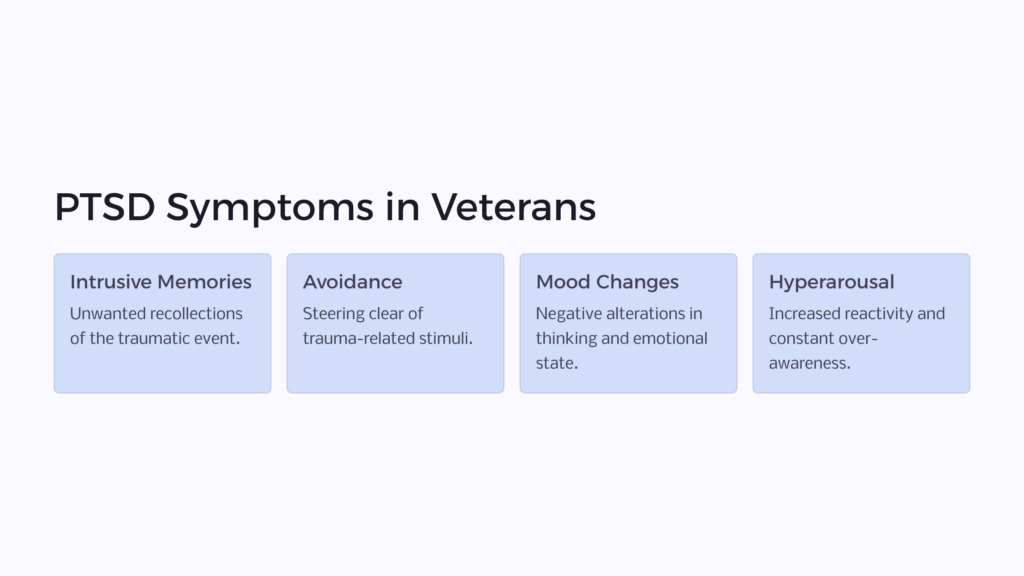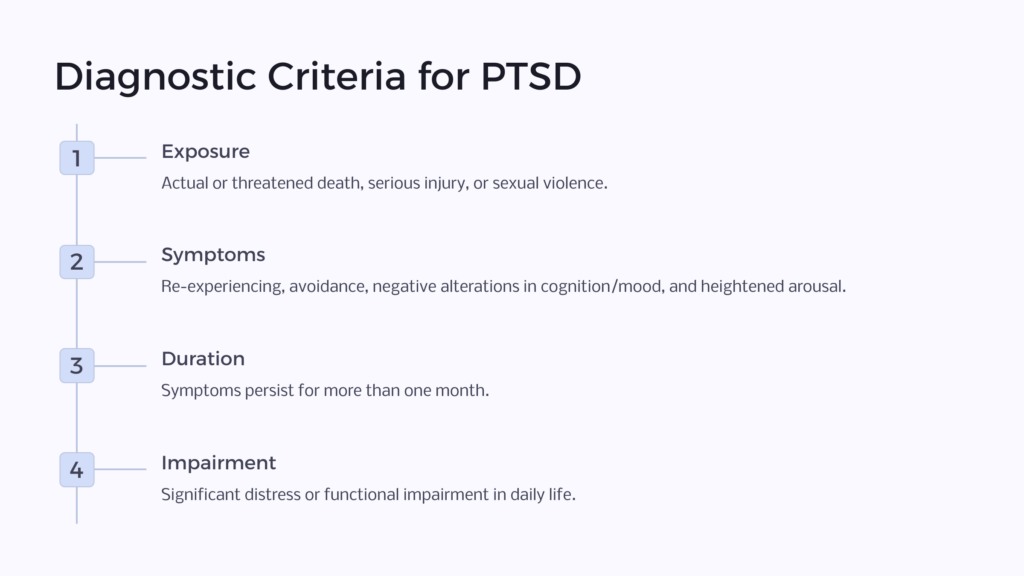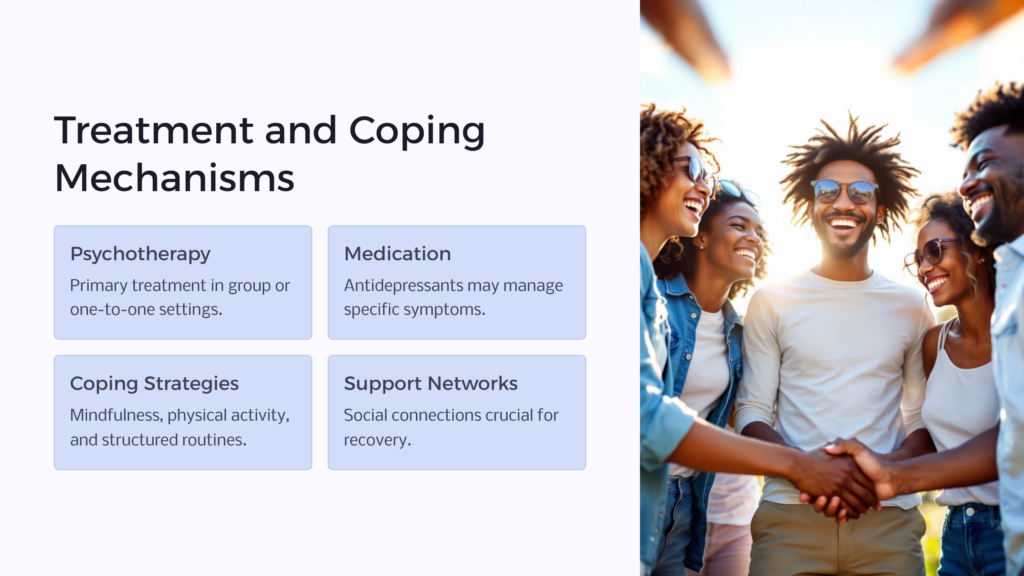What is Trauma?

Trauma is a deeply disturbing experience that overwhelms someone’s ability to cope. It produces feelings of helplessness, diminishing sense of self, and difficulty feeling a full range of emotions. This profound psychological distress can result from various incidents—from natural disasters to personal assaults—and can have lasting effects.
What is Post Traumatic Stress Disorder (PTSD)?
PTSD, or Post Traumatic Stress Disorder, is a mental health condition that can occur after experiencing or witnessing a traumatic event. It is characterized by symptoms such as flashbacks, nightmares, anxiety, and avoidance of triggers related to the trauma.
Symptoms of PTSD vary from person to person, but common ones include intrusive memories, negative changes in mood and thinking, hyperarousal (constant over-awareness), and avoidance of reminders of the traumatic event. These symptoms can significantly impact a veteran’s daily life and functioning.
For example, a veteran with PTSD may have difficulty sleeping due to nightmares and intrusive memories. They may also experience heightened anxiety and hypervigilance, making relaxing or feeling safe in their surroundings challenging. Additionally, they may avoid situations or places that remind them of the traumatic event, limiting their ability to engage in normal activities. Understanding the unique experiences and symptoms of PTSD in veterans is crucial to providing effective treatment and support.
PTSD Symptoms & Diagnosis

The PTSD symptom list can be grouped into four types: intrusive memories, avoidance, negative changes in thinking and mood, and changes in physical and emotional reactions. These symptoms can vary over time or vary from person to person. They can cause significant problems in social or work situations and in relationships while also interfering with one’s ability to perform daily tasks.
For a PTSD diagnosis, an adult must have all of the following for at least one month: at least one re-experiencing PTSD symptom, at least one avoidance symptom, two cognition and mood PTSD symptoms, and two arousal and reactivity PTSD symptoms. Children and teenagers can have different symptoms than adults, including ones relating to play or friendships.
The Unique Experience of PTSD in Veterans
PTSD in veterans is a complex issue that deserves attention due to the unique challenges of their service. These challenges can range from reintegration into civilian life to ongoing physical and psychological trauma. Understanding and addressing PTSD in veterans is crucial for providing them with the support and care they need.
Why are Veterans More Susceptible to PTSD?
Veterans are more susceptible to PTSD because of experiences during military service. They may have been exposed to intense combat situations, witnessed the death or injury of comrades, and endured prolonged periods of stress and fear. These traumatic events can profoundly impact mental and emotional well-being, increasing PTSD prevalence among veterans. Additionally, the challenges of transitioning to civilian life and the stigma surrounding mental health in the military can further compound the risk of PTSD in vets.
Diagnostic Criteria for PTSD (DSM-5)

The DSM-5 criteria for PTSD involve exposure to actual or threatened death, serious injury or sexual violence. These events must also create persistent re-experiencing of the trauma, avoidance of stimuli related to the trauma, negative alterations in cognitions or mood, and heightened arousal and reactivity.
Overview of DSM-5 Diagnostic Criteria for Veterans’ PTSD Ratings
For veterans, PTSD ratings follow the DSM-5 criteria, where it’s observed if the veteran has been exposed to a traumatic event, followed by PTSD symptoms. Depending on the symptom severity, veterans can get a disability rating from 0% to 100%.
The DSM-5 diagnostic criteria for PTSD include exposure to actual or threatened death, serious injury, or sexual violence. This exposure must lead to persistent re-experiencing of the trauma, avoidance of trauma-related stimuli, negative changes in mood and thinking, and heightened arousal and reactivity. Veterans’ PTSD ratings are based on these criteria, with disability ratings ranging from 0% to 100%, depending on the severity of symptoms.
PTSD Checklist for DSM-5 (PCL-5)
PCL-5 is a 20-item self-report that assesses the DSM-5 symptoms of PTSD. It has a “past week” and “past month” version, which include items such as:
1. Exposure to actual or threatened death, serious injury, or sexual violence
2. Intrusive memories of the traumatic event
3. Nightmares related to the trauma
4. Flashbacks or dissociative reactions
5. Avoidance of trauma-related stimuli
6. Negative alterations in mood and thinking
7. Difficulty remembering important aspects of the traumatic event
8. Persistent negative emotional state
9. Loss of interest or participation in significant activities
10. Feelings of detachment or estrangement from others
11. Persistent inability to experience positive emotions
12. Irritability and angry outbursts
13. Reckless or self-destructive behavior
14. Hypervigilance
15. Exaggerated startle response
16. Problems with concentration
17. Sleep disturbances
18. Duration of symptoms for at least one month
19. Significant distress or impairment in functioning
20. Symptoms not attributable to substance use or other medical conditions
What Causes PTSD to be Triggered in Veterans?
Combat exposure, physical injury, seeing others being harmed, or extreme fear can trigger PTSD in veterans.
These experiences can activate the body’s stress response system, causing profound psychological and emotional distress. The impact of these triggers can vary from person to person, but they often contribute to the development and exacerbation of PTSD symptoms in veterans.
The DSM-5’s PTSD Criteria
Criterion A: Stressor
The person was exposed to or threatened with death, serious injury, or sexual violence. Exposure occurs via direct contact, witnessing the trauma, learning that a relative or close friend was exposed to it, or indirect exposure to aversive details of the trauma (for example, first responders may develop PTSD from repeatedly witnessing/hearing about traumatic situations, even if the event(s) didn’t happen to them).
Criterion B: Intrusion Symptoms
The traumatic event is persistently re-experienced, often in the following ways: unwanted upsetting memories, nightmares, flashbacks, emotional distress after exposure to traumatic reminders, and physical reactivity after exposure to traumatic reminders.
Criterion C: Avoidance
Avoiding trauma-related stimuli after the trauma—such as trauma-related thoughts or feelings or trauma-related reminders—is a key symptom of PTSD. In veterans, this may manifest as an aversion to crowds and fireworks, as both can be reminders of busy, loud combat situations.
Criterion D: Negative alterations in cognitions and mood (two required)
At least two of the following are required to confirm a connection to PTSD:
- Negative thought and mood changes connected to the traumatic event (like inability to recall key features of the trauma)
- Overly negative thoughts and assumptions about oneself or the world
- Exaggerated blame of self or others for causing the trauma
- Negative affect (a term for emotional distress that causes a wide range of negative emotions)
- Decreased interest in activities
- Feeling isolated
- Difficulty experiencing positive affect
Criterion E: Alterations in arousal and reactivity
The vet or individual demonstrates trauma-related arousal and reactivity changes like:
- Irritability or aggression
- Risky or destructive behavior
- Hypervigilance
- Heightened startle reaction
- Difficulty concentrating
- Difficulty sleeping
Criterion F: Duration
Symptoms must last for more than one month.
Criterion G: Functional significance
Symptoms create distress or functional impairment, like in social, occupational, or other important areas.
Criterion H: Exclusion
Symptoms are not due to medication, substance use, or other illness. In other words, PTSD has developed on its own and won’t go away just by changing the body’s chemistry.
Complex PTSD: An Expansion
What Is Complex PTSD?
Complex PTSD, sometimes known as C-PTSD, indicates a more severe form of PTSD that can occur after prolonged, repeated trauma, like ongoing domestic abuse, childhood neglect, or torture. People with C-PTSD often encounter additional symptoms, including difficulties with emotional regulation, negative self-concept, and difficulties in relationships.
Other Types of PTSD
There are typically four types of PTSD, as identified by the DSM-5: normal stress response, acute stress disorder, uncomplicated PTSD, and complex PTSD.
The first type, the normal stress response, typically involves transient symptoms that resolve within a few days or weeks following a traumatic incident.
Acute stress disorder, the second type, manifests as severe anxiety and dissociative symptoms within one month of exposure to trauma. With timely intervention, individuals with acute stress disorder often recover within a short period.
Uncomplicated PTSD, the third type, encompasses persistent re-experiencing of the traumatic event, avoidance, and heightened arousal, lasting beyond one month. These symptoms can significantly impact daily functioning and require targeted therapeutic interventions for resolution.
Finally, complex PTSD, the fourth type, involves prolonged exposure to trauma, often within interpersonal relationships, leading to a broader range of symptoms, including emotional dysregulation, interpersonal difficulties, and a distorted self-perception.
Treatment and Coping Mechanisms

The primary treatment for both PTSD and Complex PTSD is psychotherapy, which could be conducted in a group or one-to-one setting. Medication, such as antidepressants, may also be used to manage specific symptoms.
Coping mechanisms for PTSD include mindfulness techniques, physical activity, structured routines, and social support networks amongst others. The difficulty is that what works for one person might not work for another, which is why personalized treatment plans are crucial.
The Veterans Crisis Line
The Veterans Crisis Line is a vital resource for veterans dealing with PTSD or any other crisis. It provides confidential help 24 hours a day, seven days a week. You can contact them through their website: Veterans Crisis Line.
And feel free to contact us here at Benefits.com for help too! We are not a crisis hotline but we do have resources to direct you to the help you need if you have any questions, need further information, or simply need someone to talk to.
 Benefits.com Advisors
Benefits.com Advisors
With expertise spanning local, state, and federal benefit programs, our team is dedicated to guiding individuals towards the perfect program tailored to their unique circumstances.
Rise to the top with Peak Benefits!
Join our Peak Benefits Newsletter for the latest news, resources, and offers on all things government benefits.


















